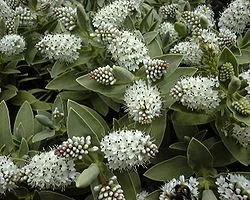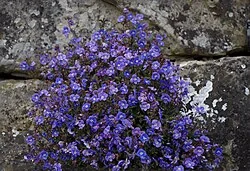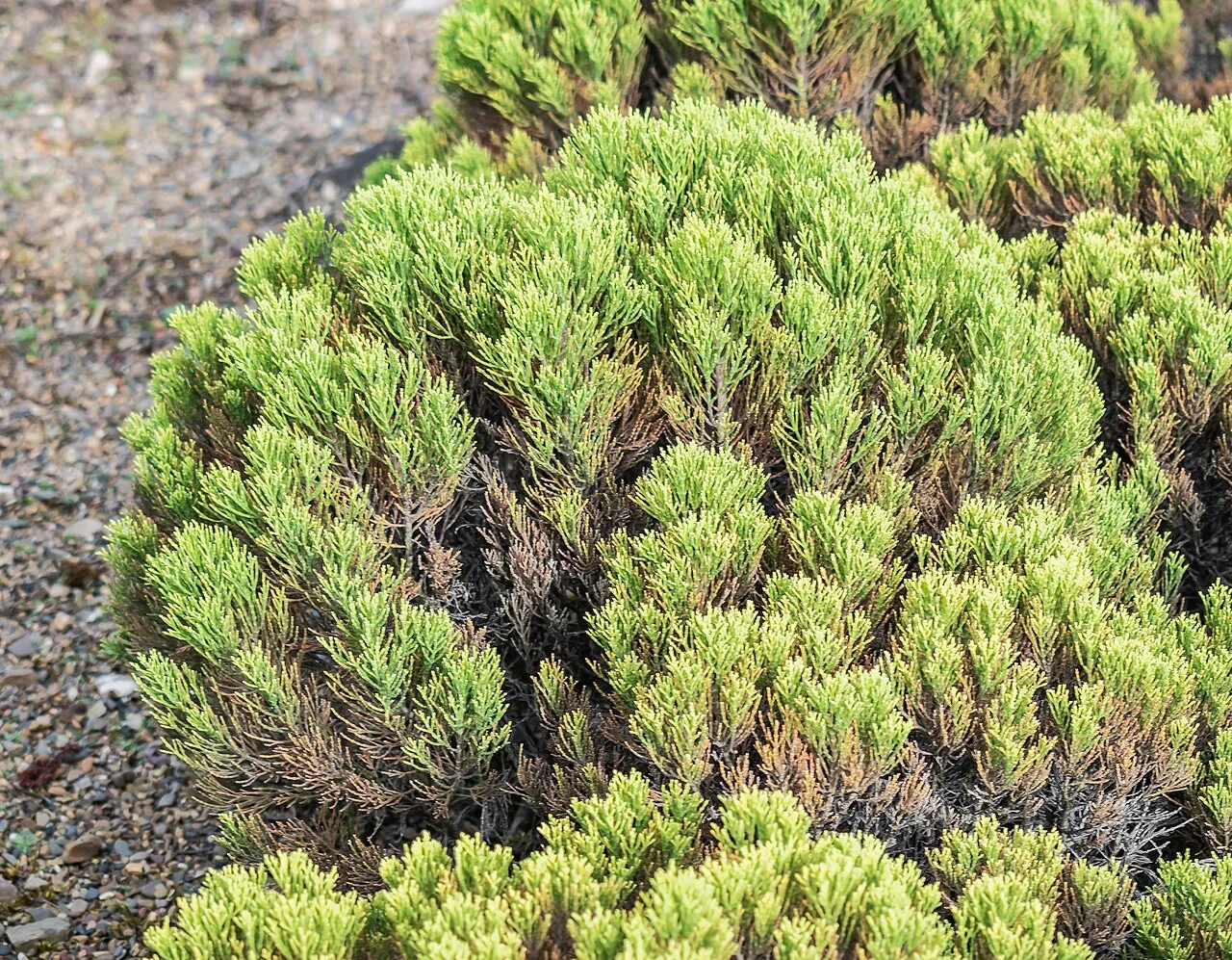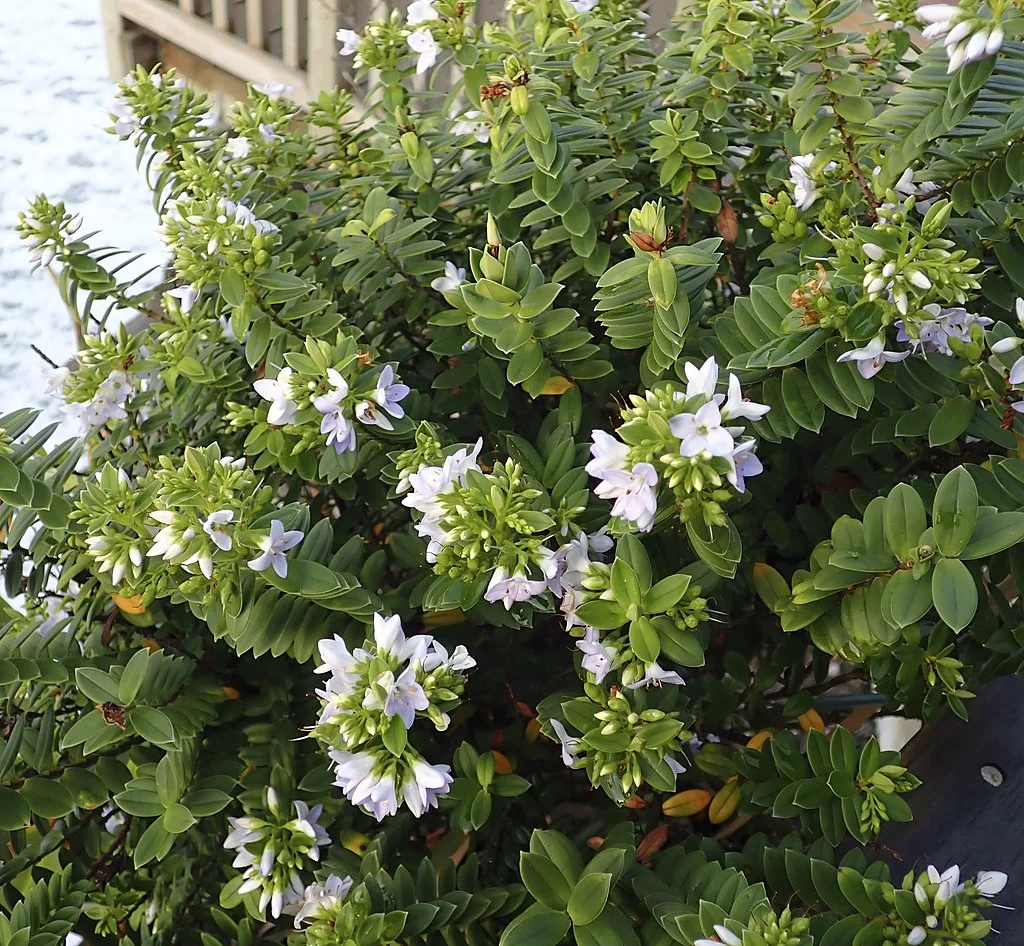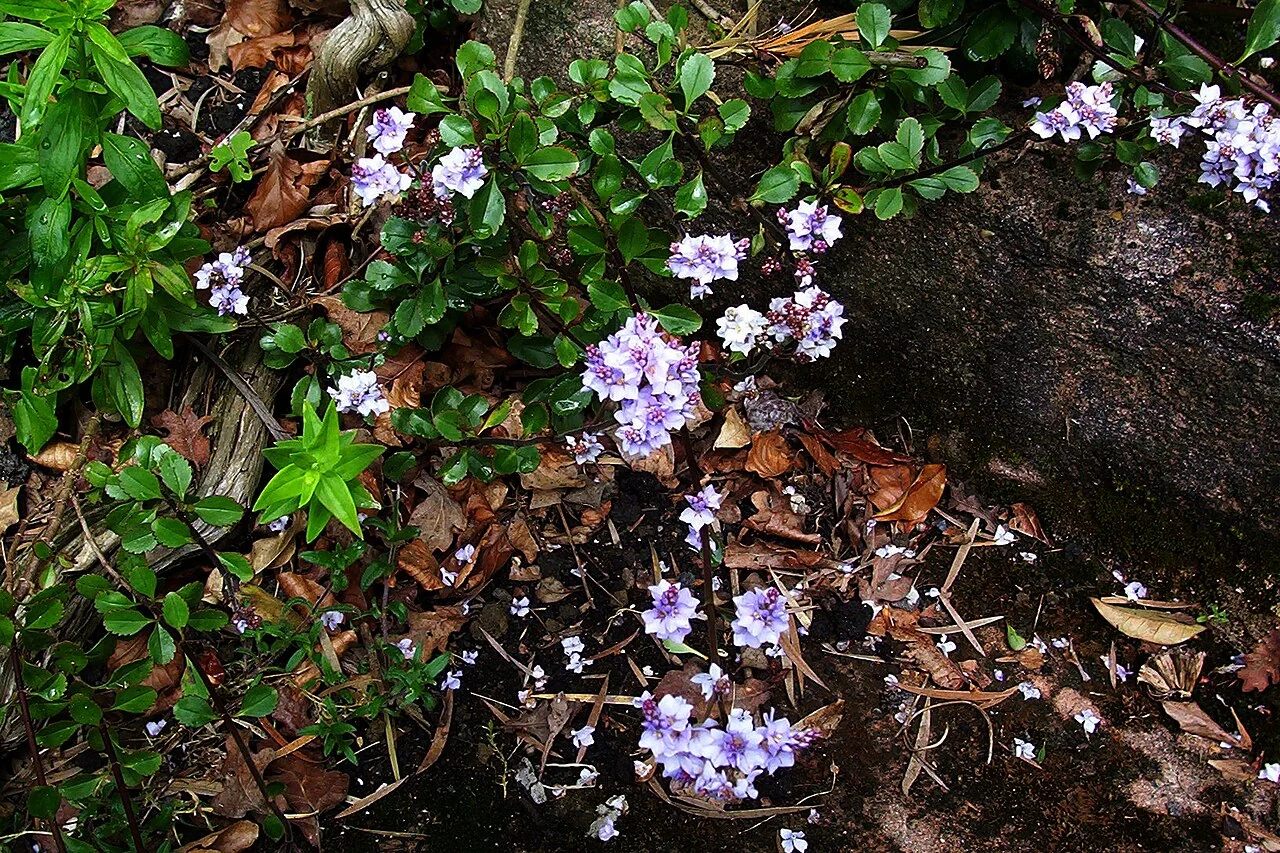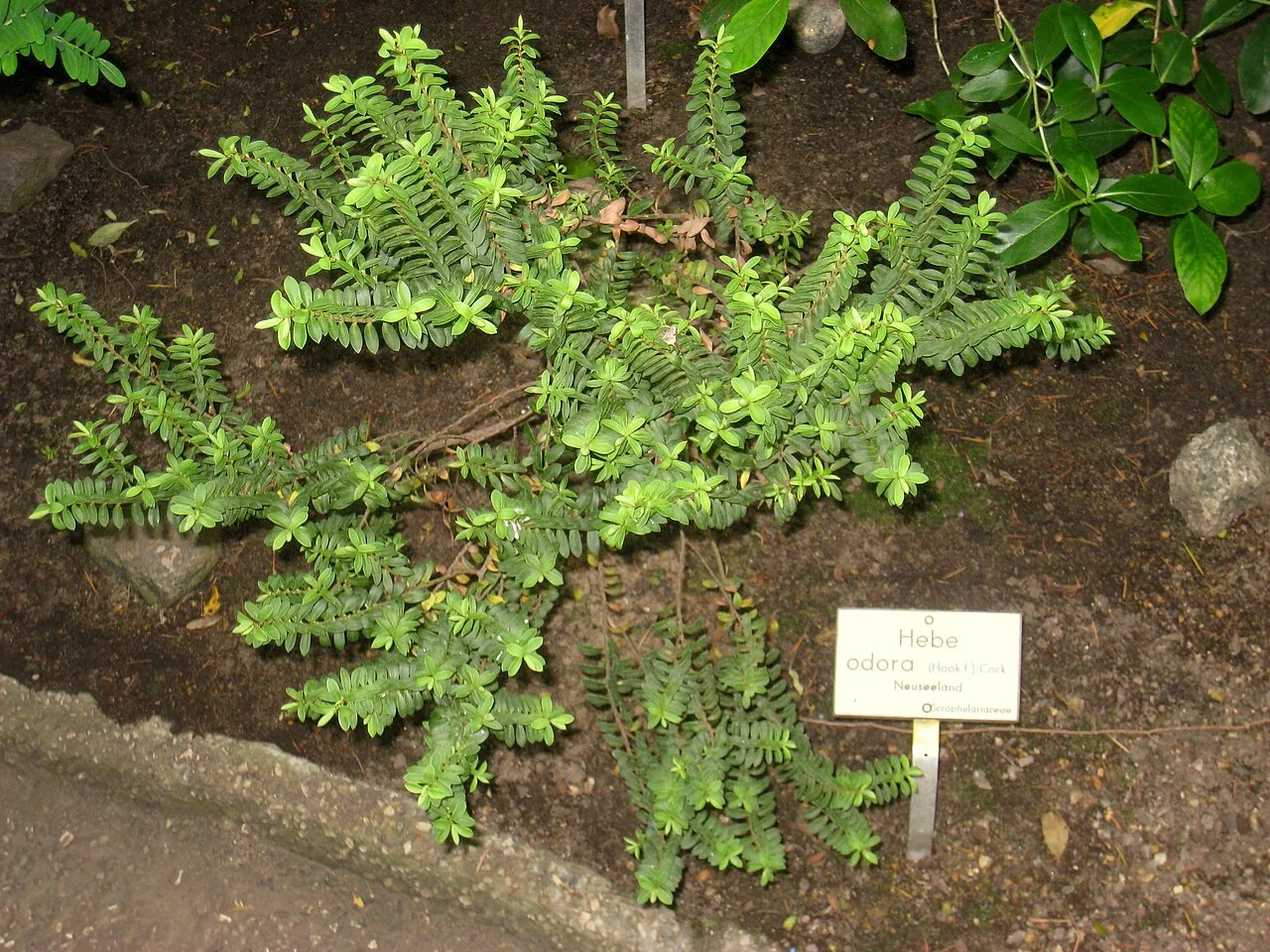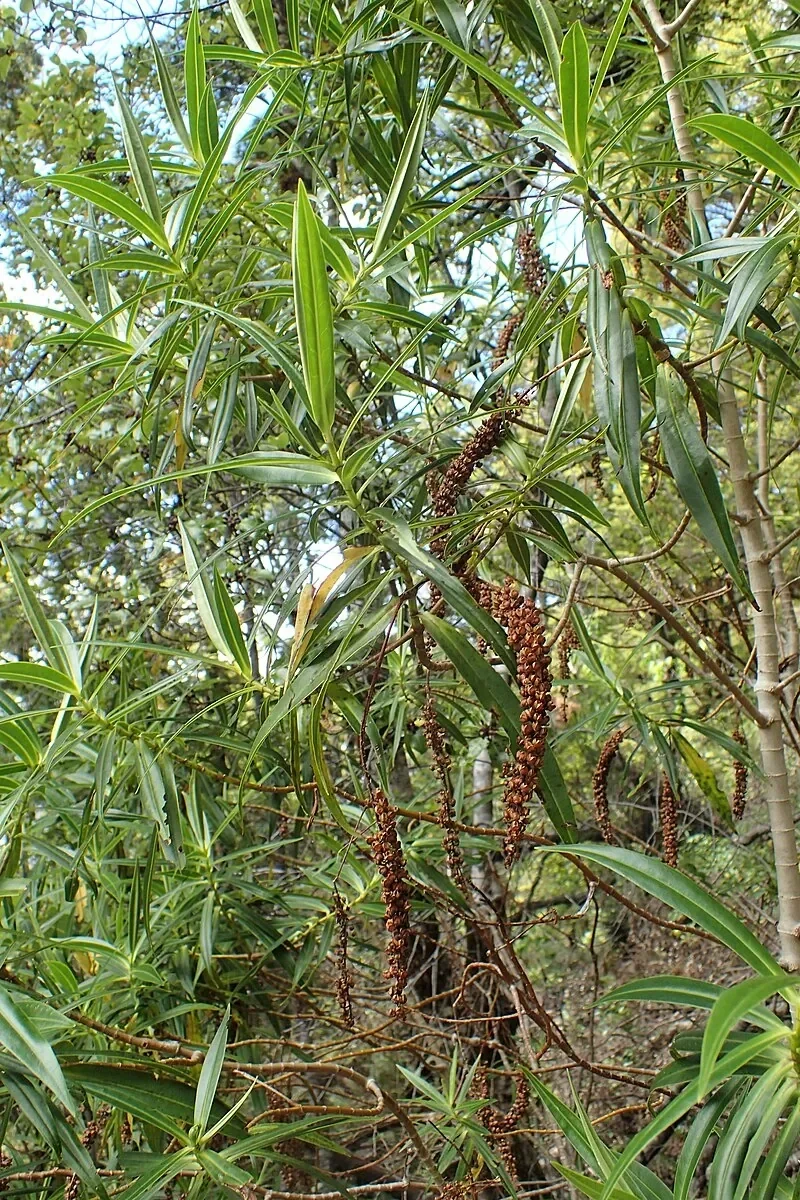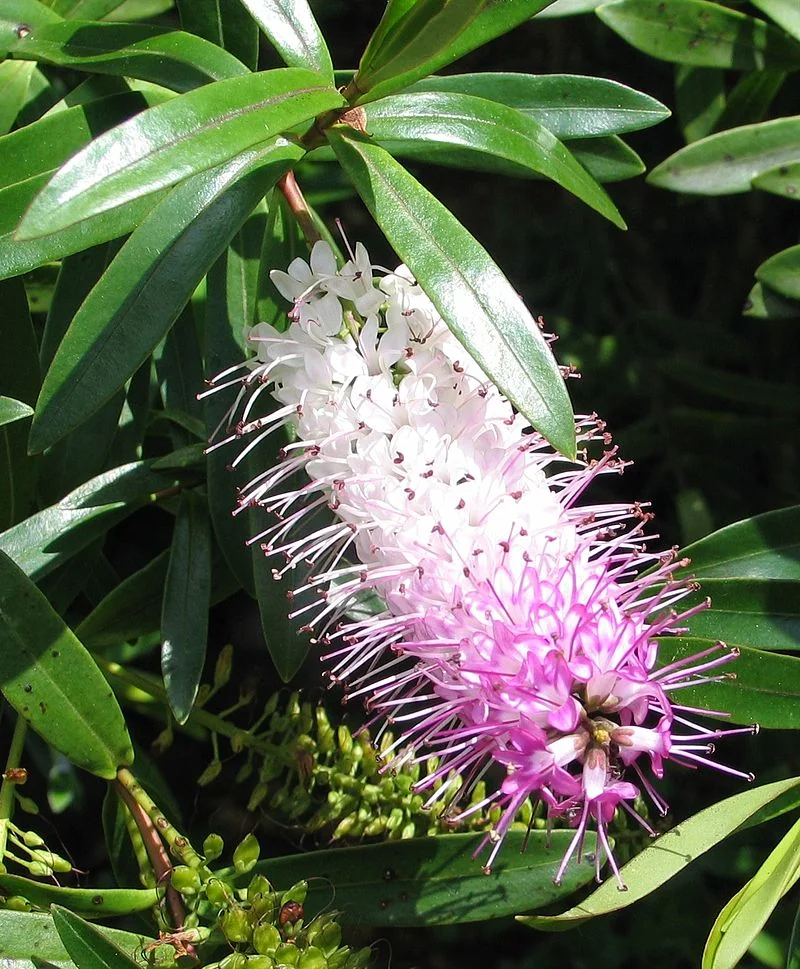
Napuka
Veronica speciosa
Introduction
Showy Hebe (scientific name: Veronica speciosa ) is a spectacular native shrub renowned for its large, vibrant flower spikes that bloom in magnificent displays of purple, pink, or white. This robust evergreen shrub is one of New Zealand's most ornamental native plants, featuring glossy green leaves and an impressive flowering performance that attracts both gardeners and native wildlife. Endemic to New Zealand, it's highly prized for landscaping and garden design. Explore more in the native plants index .

Napuka ( Veronica speciosa ) is a native species valued in gardens and restoration for its form and resilience in suitable conditions. Learn more about native shrubs in our native plants guide.
Plant Description
Botanical Features
Napuka ( Veronica speciosa ), also known as New Zealand hebe or showy hebe, is an evergreen shrub native to New Zealand. It typically grows as a spreading to somewhat sprawling shrub, reaching heights of 1 to 2 meters and widths of up to 3 meters. It is characterized by its stout, woody branches and glossy, dark green, thick, and leathery leaves, which can be 50-200 mm long and 25-80 mm wide. The leaves often have a distinctive pink-red pigmented, finely hairy margin. Veronica speciosa produces showy, densely packed flower spikes, up to 15 cm long, with flowers ranging in colour from pale pink to bright magenta or violet/purple. Each flower is small, typically less than a centimeter wide, with a four-lobed corolla and two prominent stamens that give the inflorescence a "whiskery look." It flowers from early summer to late autumn, and sometimes year-round.
Quick Facts
Essential Information
| Scientific Name | Veronica Speciosa |
|---|---|
| Height | 1 - 2 m |
| Spread | 1 - 1.5 m |
| Water Needs | Moderate |
| Light | Full sun to partial shade |
| Frost Tolerance | Moderate; can be frost tender |
| Salt Tolerance | High |
| Growth Rate | Moderate to fast |
| Lifespan | Shrub |
Climate Best Suited to
Napuka is naturally a coastal plant, found in the North Island and Marlborough. It thrives in mild, coastal climates and is tolerant of wind and salt spray. It can be sensitive to heavy frosts, so in colder regions, it's best planted in a warm, sheltered spot.
Regional Suitability
| Whangārei | Ideal |
| Auckland | Ideal |
| Hamilton | Suitable |
| Rotorua | Suitable |
| Tauranga | Ideal |
| Gisborne | Ideal |
| New Plymouth | Ideal |
| Whanganui | Ideal |
| Palmerston North | Suitable |
| Napier | Ideal |
| Wellington | Ideal |
| Nelson | Ideal |
| Christchurch | Suitable |
| Dunedin | Suitable |
| Invercargill | Suitable |
| City | Climate Suitability |
|---|
Natural Habitat
Napuka ( Veronica speciosa ), also known as New Zealand hebe or showy hebe, is an evergreen shrub native to New Zealand. It is predominantly found in the temperate regions of the Southern Hemisphere, particularly in coastal areas of the North Island and Marlborough.
Key Habitats Include:
- Coastal Areas: It typically grows in coastal areas, including cliffs and headlands, within low windswept scrub and flaxland. This highlights its exceptional tolerance to salt spray and strong winds.
- Open Woodlands and Alpine Regions (less common): While it can be found in open woodlands and alpine regions, it rarely grows under taller trees, indicating its preference for open, well-lit environments.
Preferred Conditions:
- Mild, Coastal Climates: It thrives in mild, coastal climates and is tolerant of wind and salt spray.
- Full Sun to Partial Shade: It performs best in full sun to partial shade.
- Well-Drained Soil: It prefers well-drained soil.
- Frost Sensitivity: It can be sensitive to heavy frosts, so in colder regions, it's best planted in a warm, sheltered spot.
The presence of Veronica speciosa in these specific habitats underscores its ecological importance in contributing to the biodiversity and structural complexity of New Zealand's natural coastal landscapes.
Plant Conservation
Veronica speciosa , also known as New Zealand hebe or showy hebe, is an evergreen shrub endemic to New Zealand, where it is classified as "Nationally Vulnerable." The plant naturally inhabits coastal areas, particularly cliffs and headlands, in low windswept scrub and flaxland. Historically, it was found from the Marlborough Sounds to Northland. Current natural populations are mainly located on the west coast of the North Island and a single site in the South Island. The primary threats to Veronica speciosa are weed invasion in its coastal habitat, browsing by animals, and genetic pollution. Genetic pollution occurs when other Hebe species and cultivars are planted near wild populations, leading to hybridization. Some southern populations, believed to have originated from deliberate Māori plantings, exhibit limited genetic variability, which hinders their ability to reproduce sexually. Several populations in the Marlborough Sounds are thought to be extinct. Conservation efforts and management opportunities include surveying for new locations, marking known sites, protecting habitats, collecting seeds for propagation and re-establishment, and raising awareness.
Growing Requirements
Soil Requirements
Showy Hebe ( Veronica speciosa ) thrives in well-draining soil, tolerates various soil types. Understanding its natural habitat in coastal areas and forest margins helps guide successful cultivation.
- Natural habitat: coastal areas and forest margins
- Soil preference: well-draining soil, tolerates various soil types
- Good drainage important for healthy root development
- Benefits from organic matter incorporation where appropriate
- Avoid conditions that differ significantly from natural habitat
Light Requirements
Showy Hebe ( Veronica speciosa ) performs best in full sun to partial shade. This reflects its natural growing conditions and ensures optimal growth and health.
- Preferred light conditions: full sun to partial shade
- Plant in position that mimics natural habitat
- Consider seasonal light changes in garden placement
- Protect from extreme conditions if necessary
Water Requirements
Showy Hebe ( Veronica speciosa ) has moderate, tolerates some drought. Understanding these needs ensures successful establishment and long-term health.
- Water requirements: moderate, tolerates some drought
- Regular watering important during establishment
- Adjust watering to match natural habitat conditions
- Monitor for signs of water stress
- Mulching can help maintain appropriate soil moisture
Planting Guide
Veronica speciosa , also known as Hebe speciosa or New Zealand hebe, is an evergreen shrub native to New Zealand, offering year-round glossy green foliage and vibrant flowers from summer to fall. It's a popular choice for gardens due to its aesthetic appeal and ability to attract pollinators like bees and butterflies.
1. When to Plant
The best time to plant Veronica speciosa is in spring or fall when the soil is warm, allowing the roots to establish before extreme temperatures arrive. In colder climates, planting from spring to autumn is suitable, while in hotter climates, autumn to early spring (before the first heat wave) is recommended.
2. Where to Plant (Location)
- Sunlight: Hebes prefer full sun to partial shade. More sunlight generally leads to more vibrant flowers. In hotter climates, some afternoon shade can help protect the leaves from sunburn.
- Soil: Well-drained soil is essential for Veronica speciosa . It is not overly particular about soil pH, thriving in slightly acidic to neutral soils. If your garden has heavy clay or poorly draining soil, amend it with organic matter or grit to improve drainage.
- Climate: While generally hardy, some varieties are more frost-sensitive. In colder regions, choose hardier varieties or provide winter protection, such as a layer of mulch around the base or covering the plant with a frost cloth. Veronica speciosa is also tolerant of coastal conditions.
3. How to Plant
-
In Borders:
- Plant as soon as possible after purchasing.
- Dig a hole twice the size of the root ball.
- Mix compost or well-rotted manure into the bottom of the hole to boost nutrients.
- Place the plant in the hole, ensuring the top of the root ball is level with the surrounding soil.
- Backfill the hole and gently firm the soil around the base.
- Space plants about 90cm (3ft) apart if growing in groups. For a hedge, space plants 30cm (1ft) apart, or 45cm (18in) for larger cultivars.
- Water thoroughly to settle the soil and continue to water regularly for the first season, especially in warm, dry weather.
-
In Containers:
- Choose a large container, 30-40cm (1ft-16in) in diameter, with large drainage holes.
- Use a peat-free multipurpose potting compost, or a loam-based compost like John Innes No. 2, mixed with coarse grit or perlite to improve drainage.
- Position the plant so it sits at the same level it was in its previous pot.
- Water generously to settle the compost, then water regularly throughout summer.
4. Care Guide
- Watering: Veronica speciosa needs regular watering during the first few months after planting to establish roots. Once established, it is fairly drought-tolerant but benefits from occasional watering during dry spells. A regular weekly watering schedule is ideal to keep the soil moist.
- Fertilizing: While not heavy feeders, a light application of balanced fertilizer in the spring can encourage growth and flowering. Avoid over-fertilizing, which can lead to leggy growth. For container-grown plants, feeding every spring can be beneficial.
- Pruning: Prune lightly in early spring to remove dead or damaged branches and maintain shape. Some varieties can be pruned after flowering to encourage a second bloom. Pruning once a year after flowering, removing up to a third of the foliage, can encourage new growth. Any frost-burnt stems can be pruned towards the end of March after a harsh winter.
- Pests and Diseases: Veronica speciosa is generally robust. However, it may be susceptible to aphids, spider mites, downy mildews, fungal leaf spot, fungal rot, and Phytophthora . Ensure well-drained soil and avoid overhead watering to prevent issues. If pests appear, treat with insecticidal soap or neem oil. Veronica speciosa is also a high-risk host for Xylella fastidiosa .
5. Propagation
Veronica speciosa can be propagated by seed or by semi-hardwood cuttings. Cuttings from healthy, non-flowering shoots are recommended, especially for specific cultivars. Dip cuttings in rooting hormone and plant in a mix of compost and sand, keeping the soil moist.
Ecological Role
Garden Nectar Source
Large, colourful flower spikes of Veronica (Hebe) speciosa are rich in nectar and pollen, supporting bees and other pollinators in coastal and lowland gardens.
Uses and Significance
Landscaping Applications
- Feature Plant: Its spectacular flowers make it a prime candidate for a feature spot in the garden.
- Coastal Gardens: An excellent choice for seaside gardens where it can withstand salt-laden winds.
- Hedging: Can be used to create a stunning informal hedge or screen.
- Pollinator Garden: The flowers are highly attractive to bees, butterflies, and other pollinators.
Cultural Significance
Traditional Uses and Values
Veronica speciosa , also known as New Zealand hebe or showy hebe, holds significant cultural importance, particularly within Māori culture. In Māori culture, the New Zealand hebe was traditionally used in various rituals and ceremonies, symbolizing protection and resilience. Its hardy nature is seen to reflect the strength and endurance of the indigenous people of New Zealand. In Western cultures, Veronica speciosa has come to symbolize beauty and adaptability. Its ability to thrive in diverse environments represents resilience and perseverance, making it a popular choice in floral arrangements to convey messages of strength and beauty. The primary symbolism of the New Zealand hebe is its beauty and resilience, with its vibrant, long-lasting blooms and ability to withstand different environmental conditions making it a symbol of enduring beauty and strength. It is also associated with protection and adaptability, highlighting its symbolic role as a guardian of natural beauty and a testament to the power of adaptation.
Landscaping Ideas
Coastal Hedging and Colour
Use for low hedges and massed colour in coastal gardens; prune lightly after flowering to keep compact. Pairs well with Coprosma and coastal grasses.
Seasonal Care Calendar
Spring
Spring is an active growth period for Showy Hebe ( Veronica speciosa ). New growth emerges and this is an ideal time for planting new specimens. Monitor soil moisture as temperatures warm and growth accelerates.
- Active growth period with new development
- Ideal time for planting new specimens
- Monitor soil moisture as growth increases
- Apply organic mulch if needed
Summer
Summer is typically the main growing season for Showy Hebe ( Veronica speciosa ). Summer to autumn flowering occurs during this period. Ensure adequate watering during hot, dry periods according to the plant's specific needs.
- Peak growing season with active development
- Monitor watering needs during hot weather
- Flowering period: summer to autumn
- Established plants show good heat tolerance with appropriate care
Autumn
During autumn, Showy Hebe ( Veronica speciosa ) begins to slow its growth as temperatures cool. This is another good time for planting as conditions become more favorable. Reduce watering frequency but maintain appropriate soil moisture.
- Growth slows as temperatures moderate
- Good time for planting new specimens
- Reduce watering frequency gradually
- Maintain appropriate soil moisture for species
Winter
Winter is typically a dormant period for Showy Hebe ( Veronica speciosa ), with minimal growth activity. Reduce watering but ensure plants don't completely dry out if they require consistent moisture. Most New Zealand natives are cold-hardy.
- Dormant period with minimal growth activity
- Adjust watering to seasonal needs
- Generally cold-hardy in most New Zealand climates
- Minimal winter protection required for most natives
When to Prune and How Much
Overview
Showy Hebe ( Veronica speciosa ) generally requires minimal pruning to maintain its natural form and health. Most maintenance involves removing dead or damaged growth and light shaping if needed.
- Remove dead, damaged, or diseased growth as needed
- Light pruning to maintain shape if desired
- Prune after flowering if applicable
- Avoid heavy pruning which can stress the plant
- Use clean, sharp tools to prevent disease
- Most natives maintain good form without regular pruning
Always use clean, sharp tools when pruning to minimize disease risk. Native plants typically maintain their natural form well and often require less intervention than exotic species.
How to Grow Napuka
Napuka, or Showy Hebe, is a vibrant and relatively easy-to-grow evergreen shrub that brings a bold splash of colour to any garden. Its large, glossy leaves and spectacular flower spikes make it a popular choice for coastal gardens, mixed borders, and as a specimen plant. Thriving in mild climates, it is particularly valued for its tolerance to wind and salt spray. With proper care, Napuka will provide a stunning display of flowers from summer into autumn, attracting pollinators and enhancing the garden's biodiversity.
From Cuttings
Propagating Napuka from cuttings is a highly effective and popular method, ensuring that new plants retain the exact characteristics of the parent. Take semi-hardwood cuttings, about 4-6 inches long, from healthy, non-flowering shoots in late summer or early autumn. Remove the leaves from the bottom half of the cutting and, if desired, dip the cut end in a rooting hormone. Plant the cuttings into a well-draining mix of perlite and peat or a similar sterile medium. Keep the cuttings in a warm, sheltered spot with plenty of indirect light, and ensure the medium remains consistently moist but not waterlogged. Rooting typically occurs within a few weeks to a few months, after which the new plants can be potted on and grown for a season before being planted out into their final position.
From Seed
Growing Napuka from seed is also possible, though it can be a slower process and the resulting plants may exhibit some genetic variation from the parent. Sow fresh seeds in a tray of well-draining seed-raising mix in spring. Lightly cover the seeds with a thin layer of fine soil or grit. Keep the seed tray consistently moist and in a sheltered location, such as a greenhouse or cold frame. Germination can be improved by pre-soaking the seeds in water for 24 hours before sowing. Maintain a consistent temperature of around 18-21°C for optimal germination. Once seedlings are large enough to handle, typically after developing their first true leaves, they can be pricked out and potted into individual containers to grow on.
Pests and Diseases
Generally Healthy
Napuka is generally robust, but can be susceptible to aphids and downy mildew, especially if grown in humid conditions or without good air circulation.
Bonus Tip
Expert Growing Advice
Napuka ( Veronica speciosa ) thrives in coastal warmth but can be pruned into flowering hedges inland. Clip straight after bloom and again lightly in late summer for a second flush of colour in mild climates.
